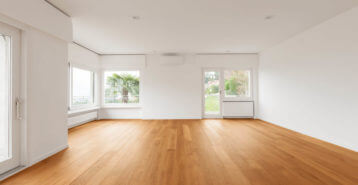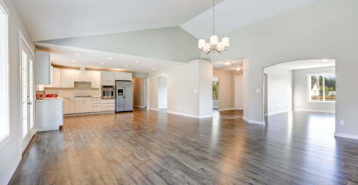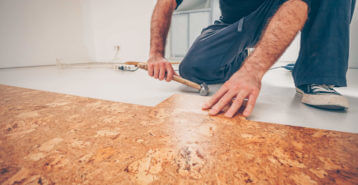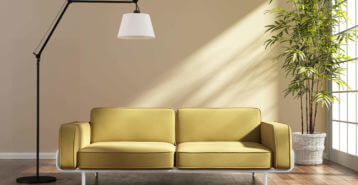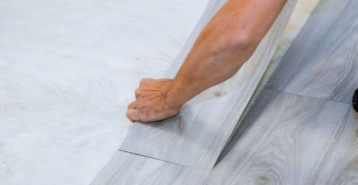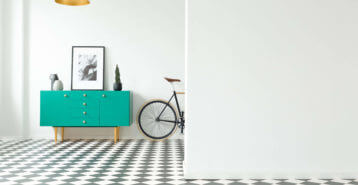Thanks to low carpet installation costs, it has been one of the most enduring types of flooring chosen by homeowners today. In this guide we provide an overview of carpet flooring installation costs. We will also review the pros and cons of carpet as a flooring option, where it works best in your home, ways to care for your new carpet and other factors to consider.
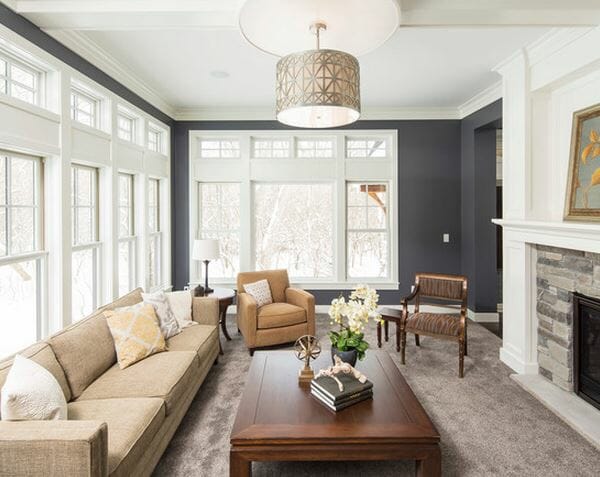
How Much Does Carpet Installation Cost?
Carpet installation can cost as little as $1 to $6 per square foot, with higher-end carpet costing up to $10 per square foot. This makes it one of the most cost-effective flooring options.
The cost to carpet a room typically varies by the type and quality of carpet, size of the room, and installation costs:
- Carpet material: $1 to $10 per square foot
- Padding: $0.30 to $1 per square foot
- Installation and labor: $0.50 to $1.50 per square foot
To give you a rough estimate, the cost to carpet a 12 x 15 room (180 square feet) would be:
- Carpet: $180 to $1,800
- Padding: $54 to $180
- Installation: $90 to $270
- Total: $324 to $2,250
If the space where you need your flooring installation is larger in square feet, you might want to choose carpet over other flooring types to keep costs down. Carpet also lasts an average 15 years, as long as you maintain it well and keep it clean.
Keep in mind that there are some higher-end carpet options, such as wool, that typically cost more per square foot. Some carpet can cost as much as $20 per square foot or more, depending on the material and its place of origin.
Carpet Installation Cost by Type
Carpet installation costs can vary depending on several factors, including the type of material, quality, brand, region, and the retailer. Installation costs also vary and can significantly impact the total price of your new flooring.
Below is a general guide to the costs associated with different types of carpet. All prices are given in a range, reflecting the low end (more basic options) to the high end (luxury options), per square foot.
| Carpet Type | Average Cost per Square Foot |
|---|---|
| Nylon | $1.50 to $5 |
| Polyester | $1 to $3 |
| Olefin (Polypropylene) | $1 to $2.50 |
| Wool | $5 to $20 |
| Triexta (SmartStrand) | $2 to $4 |
| Acyrlic | $2 to $4 |
| Blend (Nylon/Wool) | $3 to $6 |
| Berber/Loop | $1.50 to $3 |
| Frieze (Twist) | $1.50 to $4 |
| Cut and loop (Sculptured) | $2 to $4 |
The most affordable types of carpet are typically polyester, olefin, berber and nylon, which start at $1 to $1.50 per square foot. More expensive carpet types include wool and blends, which can run from $5 to $20 per square foot.
Labor Costs for Carpet Installation
During a carpet installation, you will need to factor in the cost of labor by a flooring professional. Luckily, the cost to install carpet tends to be more affordable than labor costs associated with other flooring types. You can expect carpet installation and labor to cost about $0.50 to $2 per square foot.
Keep in mind that labor costs can vary by the flooring company and where you live. It’s always best to compare three to four quotes to ensure you are getting the best price and pro for the job.
Additional Carpet Installation Costs to Consider
In addition to the costs of carpet material and labor, there may be additional costs involved to install carpet. For instance, carpet replacement costs can be higher than a new carpet installation, due to the cost of old carpet removal and disposal. Additionally, depending on the type of carpet you choose, you may require underfloor padding.
You can expect old carpet removal and disposal to cost $1 to $5 per square foot on average, while underfloor padding generally costs $0.30 to $1 per square foot.
Carpet Popularity Among Homeowners
While carpet might not be as popular as in previous generations, when it was used in nearly every area of the home outside of kitchens and bathrooms, Americans’ love of carpet continues.
According to a September 2023 survey by Modernize, 21% of homeowners indicated they already had carpet installed in their homes, making it the second most common type of flooring. However, in 2021 it was the most popular, with 30% indicating they had carpet.
Additionally, of homeowners who were planning to replace their floors, just 11% were choosing carpet in our most recent survey compared to 17% in 2021.
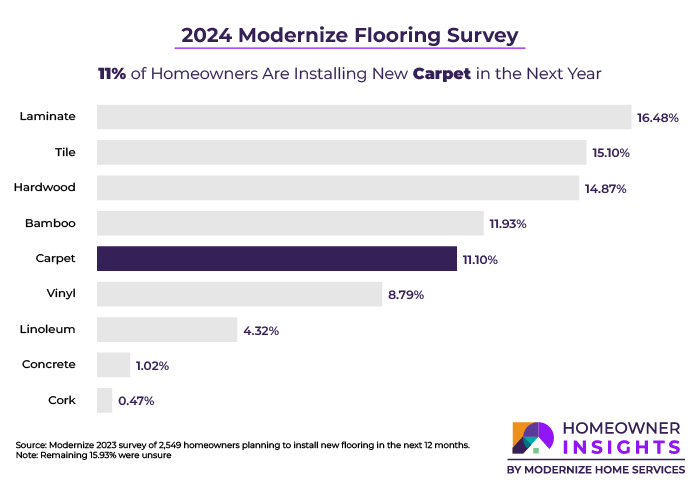
From these findings, we can surmise homeowners are replacing carpet with other flooring types more often than they are replacing flooring with new carpet.
Where Carpet Works Best in Your Home
Though its popularity is waning a bit currently, there are still many reasons to consider new carpet for your home.
When deciding which rooms in your home are best suited to carpet, it’s important to consider how those rooms are used. Carpet is an excellent choice for the following areas:
- Bedrooms
- Living rooms
- Playrooms
- Stairways
These are the areas in the home where people typically lounge, get comfortable or play on the floor. Lush carpet atop a thick carpet pad provides unmatched comfort versus other types of more solid flooring. Carpet often is used on stairs as well, since it provides increased traction and softens noise, but stairs are definitely a high-use area where carpet can show wear over time.
Advantages of Carpet
Carpet is a popular flooring choice for a host of reasons. These include:
Cost
Carpet flooring is one of the most affordable flooring types. Even high-quality carpet with a thick underpad is usually less expensive than other modern flooring options, such as tile, stone or natural wood. Carpet offers a way to upgrade your flooring without busting your renovation budget.
Comfort
Laminates, tile, hardwood and similar flooring options provide little in the way of comfort for sitting or lying down. Good carpet, on the other hand, feels soft, spongy and plush underfoot. For future reference, the denser the carpet’s filaments, the softer it feels.
Ease of installation
Installation of stone, hardwood or tile flooring can take between several days to a week or more depending on the total area being covered. Carpet and padding, however, can be installed throughout your home in just a few hours or one day by an experienced crew.
Noise reduction
Carpet and padding dampens sound within a room as well as between floors of multi-story residences. If footsteps and airborne noise are primary concerns, consider soundproofing carpet underlayment for maximum noise reduction.
Energy efficiency
Carpeting is often a sustainable flooring type. Quality carpet and padding acts as a natural insulator. Depending on the thickness of the pad and carpet, you could see a 4 to 5 percent reduction on heating costs.
Design versatility
There are literally thousands of colors, patterns and styles of carpet — it shouldn’t be hard to find an option that compliments your interior décor and personal tastes. Light-colored carpet is best for lightly traveled areas. Alternatively, medium tones such as tan, brown and beige are better at hiding wear and stains. Darker colors, meanwhile, provide a bolder, striking aesthetic. You can also try carpet tiles if you are looking for a more unique style!
Quality carpet typically is durable and won’t look matted or crushed throughout its lifecycle. Despite the many reasons to choose carpet, there are some pitfalls that come with this type of flooring.
Disadvantages of Carpet
Even the most expensive carpet is susceptible to damage. While carpet flooring can be a great choice for your home, we recommend considering the following disadvantages:
Maintenance
Carpet requires routine maintenance such as vacuuming to keep it clean, as well as regular deep cleaning to remove hidden dirt, dust and stains. However, keep in mind that over-steam cleaning can shorten the lifespan of your carpet. If you are considering carpet, maximize its lifespan with these top tips for maintaining carpet.
Pets and kids
Parents can vouch for the fact that both can be extremely hard on carpet regardless of prevention measures. Pets shed, and they also sometimes potty in the house. Removing urine stains from the carpet and odors trapped in the padding often requires professional cleaning. Kids, on the other hand, often spill and track dirt in from the outside. You’ll likely have to up your maintenance and deep cleaning schedule in kids rooms.
Moisture and allergens
Carpet retains dust, dirt, dander, pet hair, pollen and other allergens and requires routine vacuuming to remove these irritants. It also can retain moisture, which could lead to unseen mold growth underneath the carpet.
Compared to other flooring options, carpet requires more maintenance to ensure cleanliness. It also tends to be more difficult to clean than other types of flooring.
How to Find a Great Flooring Contractor
If you have decided that you would like to upgrade your flooring and carpet is the best choice for certain areas of your home, Modernize can help. Our search tools help you find quality flooring contractors in your area, who can tackle your carpet renovation project and guide you through important decisions, such as finding carpeting that fits your budget, determining quality, and more.
When discussing the project, make sure your contractor knows your flooring budget, the type and quality of carpet you want, and any other concerns you have. Communicating with your contractor transparently can better prepare the contractor to show the right kinds of carpet samples and underlayment materials.
Compare top-rated flooring pros in your area.
Read real homeowner reviews, explore qualifications, and view promotions. Modernize makes it easy to browse professionals and find one that will be perfect for your project.




